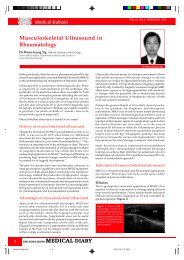MEDICAL DIARY - The Federation of Medical Societies of Hong Kong
MEDICAL DIARY - The Federation of Medical Societies of Hong Kong
MEDICAL DIARY - The Federation of Medical Societies of Hong Kong
You also want an ePaper? Increase the reach of your titles
YUMPU automatically turns print PDFs into web optimized ePapers that Google loves.
22<br />
<strong>Medical</strong> Bulletin<br />
Electrical Device-Based <strong>The</strong>rapies for<br />
Heart Failure<br />
Dr. Godwin TC Leung<br />
MBChB, FRCP, FHKAM<br />
Specialist in Cardiology<br />
Despite advances in pharmacological treatment for heart<br />
failure, there are still a growing number <strong>of</strong> patients with<br />
advanced symptoms who suffer from significant<br />
morbidity and mortality. This has given rise to the<br />
development <strong>of</strong> device-based therapies which have<br />
favourably impacted on the outcomes in patients with<br />
heart failure.<br />
Cardiac Resynchronisation <strong>The</strong>rapy (CRT)<br />
Approximately one third <strong>of</strong> patients with systolic heart<br />
failure have a QRS duration greater than 120 ms, which<br />
is most commonly seen as left bundle-branch block.<br />
Widened QRS complex represents both inter- and intraventricular<br />
conduction delays or electromechanical<br />
dyssynchrony. Such asynchronous contraction pattern<br />
contributes to mitral regurgitation, reduction in stroke<br />
volume and subsequently leading to deleterious left<br />
ventricular remodelling. CRT delivers electrical stimuli to<br />
the left and right ventricles simultaneously with the goal<br />
<strong>of</strong> synchronising the activation <strong>of</strong> both ventricles. This is<br />
achieved by introducing a specially designed pacing lead<br />
into the left ventricle -- usually implanted through an<br />
intravenous approach via the coronary sinus and into a<br />
lateral cardiac vein -- in addition to placement <strong>of</strong><br />
standard right-sided leads. <strong>The</strong> proposed mechanism <strong>of</strong><br />
benefit by CRT is to correct the dyssynchrony between<br />
the right and left ventricles and the intraventricular<br />
dyssynchrony within the left ventricle by pacing the right<br />
ventricular apex and lateral or posterolateral wall <strong>of</strong> the<br />
left ventricle. Minimising intraventricular dyssynchrony<br />
has been shown to increase left ventricular filling time,<br />
decrease septal dyskinesis, reduce mitral regurgitation<br />
and improve global left ventricular function. <strong>The</strong>se acute<br />
mechanical effects are accompanied by more chronic<br />
adaptations that lead to long-term benefits including<br />
improvements in neurohormonal status and left<br />
ventricular ejection fraction (LVEF) and reversing the<br />
adverse left ventricular remodelling 1.<br />
CRT alone or combined with implantable cardioverter<br />
defibrillator (CRTD) are now standard <strong>of</strong> care for<br />
moderate to severe heart failure patients with cardiac<br />
dyssynchrony. Results from randomised, controlled trials<br />
have consistently demonstrated significant<br />
improvements in quality <strong>of</strong> life, functional status, and<br />
exercise capacity in patients with New York Heart<br />
Association (NYHA) Class III and IV heart failure who<br />
are assigned to CRT. In these patients, cardiac<br />
resynchronisation has also been shown to improve<br />
cardiac structure and function while significantly<br />
VOL.14 NO.1 JANUARY 2009<br />
Dr. Godwin TC Leung<br />
reducing the risk <strong>of</strong> worsening heart failure. Survival<br />
benefit by CRT has also been demonstrated in<br />
COMPANION (Comparison <strong>of</strong> <strong>Medical</strong> <strong>The</strong>rapy,<br />
Pacing, and Defibrillation in Heart Failure) and CARE-<br />
HF (Cardiac Resynchronization-Heart Failure) trials. In<br />
COMPANION, CRT pacing with or without ICD<br />
capability was associated with a significant one-year<br />
relative-risk reduction <strong>of</strong> about 20% for all-cause death<br />
or hospitalisation when added to optimal medical<br />
therapy in over 1600 patients with ischaemic or<br />
nonischaemic NYHA class III to IV heart failure, an<br />
LVEF 120 ms 2. CARE-HF<br />
randomised 813 patients with NYHA class III to IV<br />
heart failure despite standard drug therapy, an LVEF<br />

















